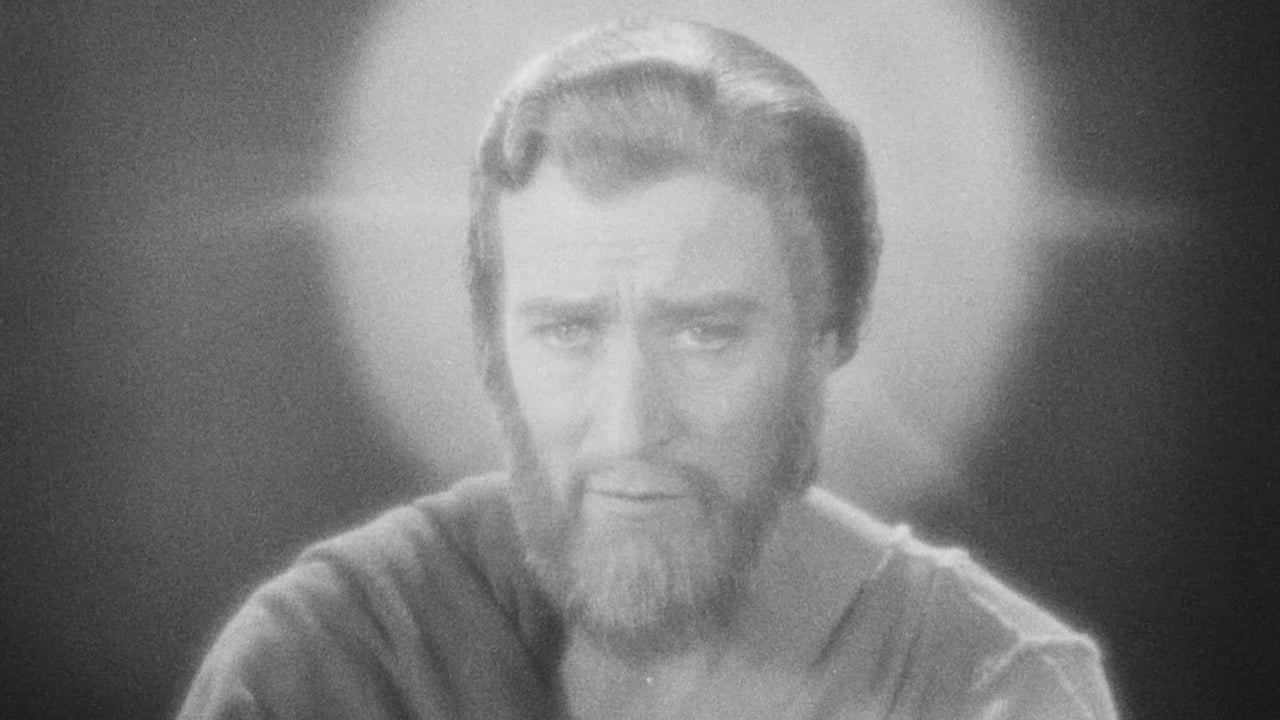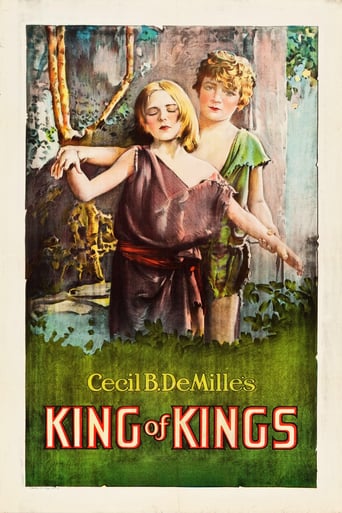

This is a thoroughly satisfying version of the Life of Christ. More than subsequent versions of The Greatest Story Ever Told, the characters seem to my mind to be more vividly portrayed and developed. Mary Magdalene as played by Jacqueline Logan and Judas Iscariot as played by Joseph Schildkraut particularly come to mind. But of course the narrative must be carried by the main character, and the first appearance of Christ upon the scene, is a grand entrance that is riveting and revelatory. This scene alone is worth the price of admission, as it sets the tone of the film. Ernest Torrence also make a stalwart companion to the Son of God as Peter, and children make surprisingly effective entrances as statements to the true mission of Christ.I particularly appreciated how many of the scenes were accompanied by passages that were book, chapter and verse from the New Testament. The narrative is conveyed in thought-provoking ways that make you consider the full meaning of the acts and thoughts of Christ, and you are tempted to crack open the Good Book in order to see if it actually states what you behold up there on the screen. I felt as though I was being given a comprehensive overview of the Life of Christ and being lightly invited to find out more.When was the last time a movie stimulated you to do that?The scene where Christ intercedes on behalf of the adulteress at the Temple is the best that I have ever seen presented in Cinema. H.B. Warner, through the expressions on his face presents a Christ who is a gentle, compassionate healer and yet able to dispassionately view the sin in others as though they were naked to his gaze. The latter quality is what makes his Christ stand out to me among other things. I also think that the way he is lit so as to always be vividly distinguishable from the other characters is one of those touches that is outstanding and pleasurable to later reflection.This version of Christ does not appeal to the sensationalistic, as it would be so easy to do considering the extraordinary quality of many of the events. This, thankfully enough, is a version that is more a theater of ideas which meditates upon the elements and spirit of an enlightened society and how it might emerge out of a corrupt regime. Here, for the first time, I felt as though I viscerally understood the confluence of political, religious and commercial tensions as they cross currents and interplay in the drama. When Pontius Palate, played by Victor Varoni, finally relents to have Christ crucified whereas he would rather wash his hands of the whole messy backwater affair and return to his life of bored leisure, I finally understood the political and religious forces at work, bought and paid for with thirty pieces of silver from friends of the money changers. Varoni's Pilate appears to feel like a pawn who's being manipulated into the final gambit of a kind of Cosmic chess game, which indeed might not be far from the truth.There is an emphasis on making clear the meaning of Christ's sojourn with us mortals here on Earth that flows from the first scene where he appears right through to the end of the narrative. This emphasis on meaning over and beyond some baroque appeal to the emotions is owed particularly to the director Cecil B. DeMille, who successfully links and creates patterns of understanding with several key concepts regarding the nature of Spirituality and the Nature of Christ. Here, all the characters appear to be struggling with passions of their own that need to be worked out to some final conclusion. I was particularly engaged watching Mary Magdalene and Judas Iscariot wrestling to reconcile the worlds of carnality and materiality with the Universe of the Spirit and its matters.The scourging of Christ and his crucifixion is subdued and presented with a restraint that lends an eerie dignity to his final hours on the cross. We find ourselves witnessing a final battle between darkness, corruption and sin and Christ as an unearthly force that allows the director with his cast and crew to work his central motif of light triumphant to a grand finale.
... View MoreMonday July 30, 7pm, The Paramount, Seattle The life of Jesus from the conversion of Mary Magdalene to the crucifixion is revealed in beatific splendor.Directed by Hollywood's master of the spectacle, The King of Kings (1927) featured Cecil B. DeMille's by then standard combination of moralizing melodrama played against dizzying production values, monumental sets, and a cast of thousands. Outwardly expressing disdain for Sunday-school stereotypes, DeMille cast fifty-two-year-old H.B. Warner in the title role, dressed him in flowing robes and bathed him in glowing light, while art directors constructed scenes reproducing the work of 298 old masters. To sanctify Jeannie MacPhereson's anti-Semitic, evangelical Christian with-a-showbiz-twist screenplay, DeMille invited members of the clergy to visit the set, and received the stamp of approval from Will Hayes. Highlights include the spectacular palace of Mary Magdalene, the Calvary tempest and bookending Technicolor scenes.Grauman's Chinese Theatre held the West Coast premiere for their grand opening, charging $22 a seat!
... View MoreJust watched on a 2-disc DVD both the 112 min. and 155 min. versions of Cecil B. DeMille's The King of Kings. While the shorter one is touching in its own right, the longer one doesn't occasionally seem rushed so it's more effective especially with the restored Peter sequences severely cut in the short one. In the longer one, the beginning sequence with Mary Magdalene, in addition to Jesus' resurrection, is also in early Technicolor. With the shorter one, I did like Hugo Riesenfeld's original score as well as the sound effects concerning the storm and earthquake as well as when Jesus knocks some tables at the temple. Timothy J. Tikker's organ score for this version sounded okay for the few minutes I heard of it. Donald Sosin's composition for the longer one was also good. While I felt some of the performances were maybe a bit exaggerated considering this was a silent picture, many of the leading ones were dramatically compelling especially H.B. Warner as Christ (who I mainly know as the much older Mr. Gower the druggist in my favorite movie, It's a Wonderful Life). As expected in these DeMille epics, the storms and earthquakes during the Crucifixion bring much excitement that must have looked really spectacular on the big screen. So if you're Catholic like I am and is very familiar with the Jesus Christ story that I've read in church during Easter all these years, Cecil B. DeMille's The King of Kings should provide ample enjoyment for you. Ratings-112 min. version: *******, 155 min. version: ********.
... View MoreCecil B. De Mille's EPIC "The King of Kings" is his New Testament follow-up to the Old Testament EPIC "The Ten Commandments" (1923). These films are better than their sound-era re-makes; their lack of spoken dialog makes them seem more reverent, somehow. DeMille even promises this, "play (is) a reverent part in the spirit of (Christ's) great command." To introduce his version of Jesus Christ (H.B. Warner), "The King of Kings" heals a blind girl - as the girl opens her eyes, Mr. Warner becomes the Christian sin-savior. It's one of many marvelous bits of film-making. For its time, this was a very artistic, well-produced film.In a foreword to accompany this picture, DeMille wrote, "At no time in the world's history has humanity so hungered for the Truth. Science has declared there is a God. And a groping, eager World cries, 'How may we find Him?' The answer goes back two thousand years, to a Man who stood with a little band of ragged followers in the midst of bigotry, cruelty and ignorance - lighting with the torch of His own life the flame of hope in the heart of man and showing us by sublime Sacrifice - Death and Resurrection - our own Immortality." DeMille takes liberties with the story, but doesn't waver too far from what could have happened in the lives of the characters. For example, since the affairs of Mary Magdalene (Jacqueline Logan) aren't explicitly documented, DeMille (with writer Jeanie Macpherson) creates one, to introduce and move the story along. With a prominently jeweled bust, Ms. Logan's "Mary" meets Christ after learning her lover, Judas Iscariot (Joseph Schildkraut), is spending too much time with the Divine one. But, in casting an older man as Christ, DeMille helps avoid possibly making Christ appear too erotic.The film benefits from some story tinkering; however, it still plays like a series of stilted vignettes - most of the time. One of the more memorable moments occurs when a girl asks Christ to "heal" her doll's broken leg. This simple scene stands out, due to its lack of miraculous content. The "special effects" highlight in "King of Kings" is the rollicking crucifixion; and, like "Ten Commandments", some color footage is included. Watch closely, and you'll see the character "Judas" steal the picture; and, overall, Mr. Schildkraut's hanging disciple is the film's most memorable character.******** The King of Kings (4/19/27) Cecil B. DeMille ~ H.B. Warner, Joseph Schildkraut, Jacqueline Logan
... View More